By Ron Wendt
“I have found some bedrock so rich, it has averaged
over $300 an hour for half a day”
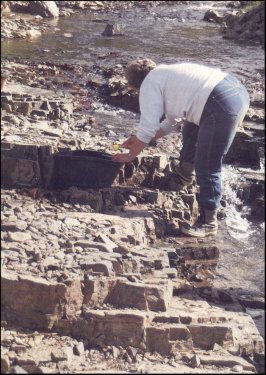 With each scoop of dirt and piece of bedrock I dumped into the bucket, it was tempting to glance over my glasses to try and catch a glimpse of gold in the pay-dirt. But having learned from experience, if I panned-out every little spoonful or trowel full of bedrock dirt, my production of bedrock gold would be sparse.
With each scoop of dirt and piece of bedrock I dumped into the bucket, it was tempting to glance over my glasses to try and catch a glimpse of gold in the pay-dirt. But having learned from experience, if I panned-out every little spoonful or trowel full of bedrock dirt, my production of bedrock gold would be sparse.
Working bedrock on most Alaskan creeks is working the cream of the crop. It is where the best pay usually is. At times, when pay-streaks become concentrated, the only good way I know of to work bedrock is by old fashioned scraping. Although you can go over the top of bedrock with a metal detector; or if it is underwater, you can dredge bedrock, there is only one way I know of to work on bedrock located high and dry, and that’s with old-fashioned hand tools.
During recent years, a lot of bedrock I have worked has been the stuff that is up high and dry. It has usually been cleared away by bulldozers, where massive amounts of the pay-streak have already been washed through sluice boxes. You would be amazed how much gold remains in bedrock cracks in places where the large equipment has already gone through. It is just a matter of finding the right pocket to dig in, and here lies the key to success.
Working bedrock can be a life of leisure. I have found some bedrock so rich it has averaged over $300 an hour for half a day, and I laid down to do it.
Obviously, the first step to take if you want to gain access to a nearly-guaranteed pay-streak is to go where the gold has already been found before in large quantities. If you have an opportunity to get out to the goldfields, and you find out who owns some of the mining claims, ask if you can do some sniping of mining ground where bedrock has been exposed and worked on an industrial scale. The nuggets usually won’t be big; but if you find the right pocket, it is possible to take out several pennyweights or even ounces of gold from bedrock traps that were missed by the heavy earth-moving equipment.
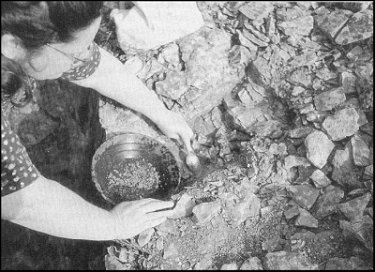 If it is convenient, sometimes I am able to drive my pickup truck close to the golden spot that I have chosen. I carry a five-gallon jug of water, a small plastic tub big enough to pan into, and a few tools for crevicing. Without having to walk down to a stream, I can pan-out my pay-dirt into the tub with water from my five-gallon jug. This makes working bedrock a lot easier.
If it is convenient, sometimes I am able to drive my pickup truck close to the golden spot that I have chosen. I carry a five-gallon jug of water, a small plastic tub big enough to pan into, and a few tools for crevicing. Without having to walk down to a stream, I can pan-out my pay-dirt into the tub with water from my five-gallon jug. This makes working bedrock a lot easier.
There are several types of bedrock in the north. Once you gain enough experience, you can eventually read bedrock like a book. Alaska has some unique formations of bedrock. There are the limestone bedrock formations in Livengood, where one old-timer used to tell me about scraping gold off its surface with a candlestick.
There is the Birch Creek schist of the Circle Mining District, which can be interspersed with granite bedrock.
The slate bedrock of the Kenai Peninsula’s gold-rich creeks is some of the most fascinating to work, and contains some very rich pockets.
Bedrock off the Koyokuk River area creeks in the Brooks Range contains unusual bedrock formations where the schist stands on end and can be peeled apart with a crow bar.
The bedrock on Jack Wade Creek in the Fortymile District contains quartzite schists, graphic schists and garnet-hornblende schists. Quartz seams are common on this creek. The gold is found not only in the bedrock, but in gravels as much as two feet above the bedrock. In the original pay-streak on Wade Creek, gold is found as deep as 1 1/2 feet into the bedrock. The origin of the gold is supposed to have been from the quartz stringers in the schists. The gold becomes black toward the head of Wade Creek. This is the result of a manganese stain in the surrounding gravel.
Canyon Creek in the Fortymile has some bedrock with a makeup of marble, schist and quartzite with occasional granite dikes running through it.
Over on Franklin Gulch, the bedrock includes micaceous, garnetiferous, hornblendic schists, and crystalline limestone. Though the gulch has a width of only 50 feet at the bottom, the bedrock has folded up considerably, and the gold is found in the bedrock at a depth of about two feet. The bedrock is so versatile in this vicinity; that over in the Chicken area, the bedrock is made up of dark-jointed shale with gold-bearing quartz and calcite seams. Clay is also known as a gold-robber in these areas, a curse to the miner; because it has a tendency to ball-up in the sluice boxes and roll on out.
When working these bedrock areas, it is always good practice to break-up all the clay that you find. Though this can be a tedious task, it may be worth doing in the long run. I have found some pretty nice little nuggets after kneading my fingers through a wad of slimy clay!
When prospecting, you do not have to become an expert in rock identification; but it does help to become aware of the essential types of rocks and bedrock that you will encounter in the field. Learning to read these rocks and layers can greatly enhance your ability to find gold.
It also helps to locate portions of the original pay-layer that were not worked by past miners. These can often prove to be very rich. Finding portions of an original pay-streak from past rich and historical creeks in Alaska can be a real and enriching thrill.
Panning out your take of pay-dirt from bedrock cracks can tell the tale of a lot of the mineral-types that are on the creek or gulch where you are prospecting. The little stones and sands that are left in the bottom of your gold pan are your heaviest minerals. If you are planning to spend an extended length of time on a creek, it might be good to save these heavies and study them. Also, if you have a small hand microscope (available at most mining supply or lapidary shops), take a closer look at the small rocks and iron sands in your gold pan. You may be surprised at how much gold is clinging to the sands or small pieces of stone!
In a lot of cases, the deepest portion of a bedrock crack or crevice will contain the most value. It is amazing how deep gold will actually penetrate.
Gold-bearing bedrock found off the Koyukuk River in the Brooks Range is generally mica-schist and slate, is uplifted, and stands on edge. Gold is found on the bedrock and inside the cleavages and crevices.
If you are in a gold-bearing area, I suggest you don’t waste too much of your time digging around smooth bedrock. Back through the eons of time when old streambeds once washed higher up on the hill or bench, most of the gold would wash right across smooth bedrock. Very rarely will gold occur on a regular basis on top of a smooth surface. The more rugged, and the more cracks in bedrock, the better your chances are of striking a rich crevice. This is generally true anywhere you go to find gold.
Once you make friends with local miners on the creek where you are going to snipe or crevice, ask the miners which side of the creek the pay happens to be most abundant, and also which stream bend or portion of the valley or gulch seems to contain the most pay. Some areas are better than others. And gold does tend to follow its own path down the waterway.
- Basics of Successful Gold Mining, Part 1
- The Basics of Successful Gold Mining, Part 2
- Basics of Successful Gold Mining, Part 3
In some places, you can use a metal detector to scan the surface of the bedrock, finding occasional nuggets. But the crevices might also have many ounces of gold scattered throughout, too disbursed to sound-out on a metal detector.
If you prospect with the right approach, you will figure it out on your own. Plan to spend some time when exploring bedrock. Finding gold does not always happen on the first pan. It takes a lot of patience, and you must possess a keen interest in what you are doing and keep your hopes kindled.
- Here is where you can buy a sample of natural gold.
- Here is where you can buy Gold Prospecting Equipment & Supplies.
- More about gold prospecting
- Schedule of upcoming events
- Books and Videos by Dave McCracken.


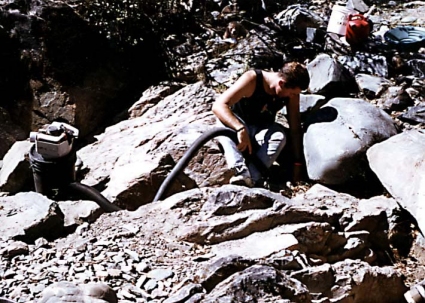
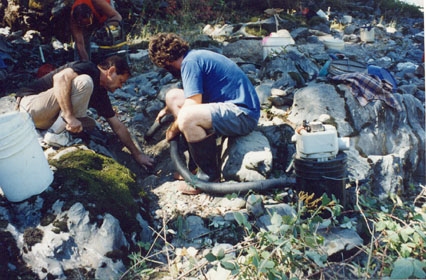
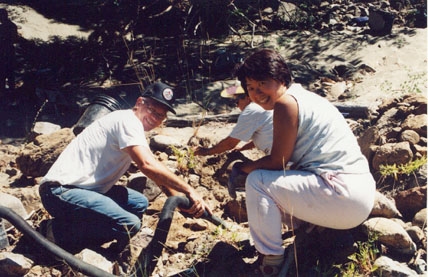
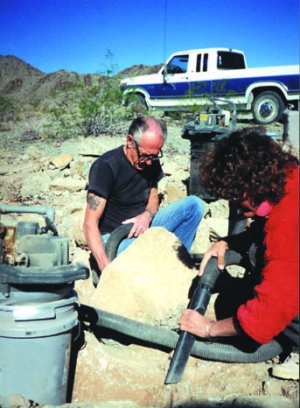 This is a picture that you will seldom see – me getting up at 5:30 a.m. full of excitement – to vacuum! Yet, I spent some of last summer and almost all of this past winter, doing just that. It wasn’t “dust bunnies” I was after, however; it was
This is a picture that you will seldom see – me getting up at 5:30 a.m. full of excitement – to vacuum! Yet, I spent some of last summer and almost all of this past winter, doing just that. It wasn’t “dust bunnies” I was after, however; it was 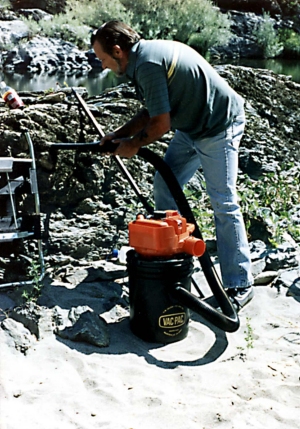 Finding new places to vack was not easy, as I have said. I have known for years, from experience, that the gold in the deserts isn’t always where it is supposed to be. What would look like great bedrock on the rivers often means nothing in the desert, mostly due to the lack of water volume and movement in the deserts. When I arrived at Quartzsite I met up with Al Powell, who is also a
Finding new places to vack was not easy, as I have said. I have known for years, from experience, that the gold in the deserts isn’t always where it is supposed to be. What would look like great bedrock on the rivers often means nothing in the desert, mostly due to the lack of water volume and movement in the deserts. When I arrived at Quartzsite I met up with Al Powell, who is also a 
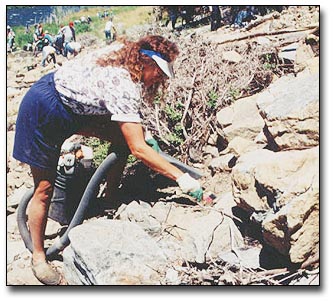 suckers
suckers



